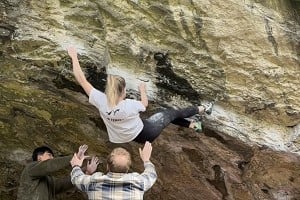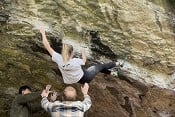
Hey everyone.
Just wondering why its frowned upon to use a overhand figure of 8 and attach this to harness using a screwgate. Suppose with indoor climbing insurance purposes and safety etc, but I still dont see this outdoors either
Just to begin with I cant say I do this myself and certainly understand why this couldn't be done on let's say lead etc so I always tie in. But for top ropping of lowering form a sports route I cant seem to understand the full scale of why it's unsafe, can anyone share some light?
There's a chance of crossloading the carabiner. Personally I'd happily do it when lowering off a sport route but on lead I wouldn't given the big difference in forces involved. I have used two crabs back to back to connect myself to the middle of a rope before, and I've thought about getting one of those belay carabiners to do so again in the future.
For lowering, people often do use a carabiner but for climbing:
1. It is an additional failure point.
2. Carabiners have weaknesses, such as cross loading, or gates opening, that a knotted rope does not. Taking a big fall with the carabiner not perfectly oriented or locked could easily break it.
It's unclear whether you're referring to tying on with a fig8 clipped to your harness with a (presumably locking) karabiner, or tying yourself into a belay using a (presumably locking) karabiner into your harness.
The latter is standard practice. The former is frowned upon mainly due to the potential for cross-loading the krab, which reduces its strength by a lot. We used to do this all the time at a wall we top-roped at in my youth, and in fairness the krab strength, even across the gate is more than enough for safe top-roping, but even so it's not a good habit to be getting into, because even relatively small lead falls may be enough to snap a cross-loaded krab.
The fewer links in the chain, the fewer possible weak spots there are.
as all the answers above plus, it's all practice for tying in properly, if you're a beginner and are serious about climbing, you might as well know your knots.
Why on earth you got a 'thumbs down' for asking about something you aren't sure about is beyond me. I gave you a thumbs up for having the sense to ask. You can get good advice on here. It's cleared things up in my mind too.
Personally I don't see a major problem with it. Pretty normal where loads of people do the same southern sandstone route for instance. Having said that, it's not without some hazards and would never be considered 'best practice '. For instance if you are too close to the rock when lowering, the screw gate barrel can be unscrewed by rubbing on the rock.
At my main climbing gym it's mandatory to clip into a belay carabiner such as the DMM Belay Master with a pre-tied figure-of-8 for toproping, but lead climbers have to thread the rope through their harness. This is mainly due to the forces involved with lead climbing. For toproping the risk assessment is different and the gym has decided it's more important to have people climb on proper 8-knots with proper belay carabiners to mitigate the chance of crossloading and improper knots.
At another gym I sometimes visit it's mandatory to tie in no matter what you're doing though, so it all depends. For toproping I like the crab better, saves a lot of time so you can get more routes in, especially now with short timeslots due to COVID and all that.
I understand the main reason is to ensure even distribution of impact energy to the waist belt and leg loops of a harness in the event of a leader fall. Just clipping into the belay loop may direct all of the energy to the leg loops with associated injury risk plus under some circumstances a risk of inversion ( bang on head), not so significant when top roping. This was very important with older harnesses, particularly the Whillans!!!! but still applies to a lesser degree with more modern harnesses
> Why on earth you got a 'thumbs down' for asking about something you aren't sure about is beyond me.
I agree, people should be brave and ask for advice. Given thumbs up. I can only *assume* the 2 thumbs down were people rejecting the use of a krab and not for asking a question (I hope)
"Faster" - Wow, you must tie in <very> slowly for this to matter!
I've actually used a system of doubled opposed carabiners for tying in when multipitching in a three and more than one person is leading individual pitches. This was with double ropes and stayed oriented nicely - two small carabiners clipped through both ropes with a nice tight loop meant no crossloading or similar problems. Worked great, and that was in the Verdon where everything is scary 😀
There is a very small chance a screwgate could rub and undo whilst climbing.
The knot threaded through binds the harness components together.
Should you lead fall, the knot tightening and pulling together of the harness all help absorb forces.
If belaying you then have two screwgates through a small loop, it's very fidgety as it's close to the body. Less room to move arms taking in etc. Also when taking on / off belay you have to unscrew the correct screwgate.
When tying into anchors and belaying, it's much harder to create a straight line, where any load from the second almost by-passes you and loads only the anchors. (Semi direct belaying).
Note. Yes many of the safety points are extremely minor, like thousands to one chances. But many of us have climbed 10s of thousands of routes, so it's best to constantly push the odds in your favour. Especially when it costs little time and saves you a screw gate!
Ps. Ignore the negative thumbs down. It's a good obvious question and shows you're thinking critically. It's good to analyse.
> Why on earth you got a 'thumbs down' for asking about something you aren't sure about is beyond me. I gave you a thumbs up for having the sense to ask. You can get good advice on here. It's cleared things up in my mind too.
It's possible someone thought the answer too obvious because it has come up before.
Personally I think it is worth restating basic safety stuff regularly as you continually get new people using the site who may not be familiar with the search functions
I do this pretty regularly when leading short grit on doubled half ropes. You can tie in using a massive fig 8 on a bight but for seconding the chance of crossloading is basically nil, and even if you did I doubt you could produce enough force to be a problem.
> multipitching in a three and more than one person is leading individual pitches
Diverting slightly from the theme of the thread, but could you elaborate on how this works?
Well we just used carabiners at both ends of the ropes - the seconds were clipped into an end each with two screwgates apiece, then the leader clipped into both lines with two carabiners total clipped through both knotted ends. When we wanted to switch leads between pitches, we all unclipped and then reclipped into the appropriate ends. This meant we never once had to flip or recoil the rope which saves a bunch of time and potential for faff over 10+ pitches.
If you wanted to be very picky about it you could do the tie-in with two maillons instead which eliminates any potential crossloading issue, but does mean slightly more faff.
Like neuromancer I will use a krab (usually use 2 screwgates back to back) when tying into the middle of a doubled half-rope when seconding on grit. I wouldn't do this when leading, for the reasons already explained, and in that set up I would always tie in to the two ends of the rope and leave the second to tie into the middle.
That makes sense, and sounds like a good idea if there's to be lots of swapping - certainly quicker than untying/retying.
(I'd had a confused and probably obtuse vision of different people leading at the same time from your initial post!)
> For lowering, people often do use a carabiner but for climbing:
> 1. It is an additional failure point.
> 2. Carabiners have weaknesses, such as cross loading, or gates opening, that a knotted rope does not. Taking a big fall with the carabiner not perfectly oriented or locked could easily break it.
More likely to break with a short fall. Less rope out to dissipate the forces involved.
> More likely to break with a short fall. Less rope out to dissipate the forces involved.
Well, that's nonsense on many levels, not least of all that the krab on the runner takes twice the load
> More likely to break with a short fall. Less rope out to dissipate the forces involved.
If you fall hard enough to generate a load that breaks a screw gate, then I'd suspect your pelvis will be wrecked beyond repair.
You can do the maths.
I saw a friend fall onto a runner about 4/5 feet off the ground and his runner karabiner snapped like chocolate!
Well, let's say you take about half a minute to properly tie a fig-8 and do a proper partner check. Not an unreasonable guestimate I'd say. Let's say you can do about ten to twenty routes per two-hour time slot (that's the slot in my gym, at least it was last year). That's five to ten minutes you spend tying in and not climbing. I'd say that is a pretty hefty percentage of your time. That's pretty much an entire route.
> Why on earth you got a 'thumbs down' for asking about something you aren't sure about is beyond me.
You don't think a down vote, might not be a "I think this is a bad idea"?
> I saw a friend fall onto a runner about 4/5 feet off the ground and his runner karabiner snapped like chocolate!
Chocolate, there in lies the problem. Get a steel one, 7kn is the usual across the gate and spine.
> You don't think a down vote, might not be a "I think this is a bad idea"?
I am sure you are right. The OP had only one 'thumb' pointing down when I first saw it. I was offering the poster some encouragement in light of this. I think it's a good thing to ask for help though it isn't always easy.
I had a mate on the forces and his instructor said that a grenade is like a block of chocolate. Their is a little bit for everyone!
The practice of tying-on without a krab was adopted before harnesses came into use. The previous system involved tying to a krab clipped to a "D" ring on a webbing waist belt. As well as the obvious problem of random orientation of the krab during a leader fall, there were cases of severe chest injuries caused by all this heavy steel whipping up as the weight was taken. The same is also possible with a harness. The "D" ring was removed first, followed later by the krab, after which you tied onto the belt with your chosen tie-in knot. Harnesses simply followed this practice, though the Whillans was rather more fiddly (what a weird, over-engineered thing it was, looking back. Yet we all used them in the 70's).
Fall factor is not directly related to the amount of rope out (ie you could take a big FF2 onto the belay with lots of rope out but fairly high impact forces) but I get what you're saying.
> Fall factor is not directly related to the amount of rope out
What is the equation for fall factors?
The fall distance/length of rope between belay and climber.
This makes maximum fall factor of 2
Yes it is.
> Fall factor is not directly related to the amount of rope out (ie you could take a big FF2 onto the belay with lots of rope out but fairly high impact forces) but I get what you're saying.
> I do this pretty regularly when leading short grit on doubled half ropes. You can tie in using a massive fig 8 on a bight but for seconding the chance of crossloading is basically nil, and even if you did I doubt you could produce enough force to be a problem.
Or you could do a bowline on night and step through the loop. Smaller knot. No krabs, easier to untie, quick as you like.
> The fall distance/length of rope between belay and climber.
> This makes maximum fall factor of 2
Sorry, I know, I was making the point that length of rope is definitely directly related to FF.
What I'm saying is that a FF2 could be 50cm or 30m. It is about the ratio of rope to fall, rather than saying short or big falls have higher impact forces.
Taking a 1m fall with 30m of rope out is not the same as taking a 60m fall onto the belay. In both situations there was 30m of rope out.
> What I'm saying is that a FF2 could be 50cm or 30m. It is about the ratio of rope to fall, rather than saying short or big falls have higher impact forces.
> Taking a 1m fall with 30m of rope out is not the same as taking a 60m fall onto the belay. In both situations there was 30m of rope out.
Exactly, amount of rope out is equally as important as distance fallen.
> Exactly, amount of rope out is equally as important as distance fallen.
Force would also be reduced with a tied knot rather than a clipped crab on a knot every man and his dog had fallen on. The force absorbed in tightening the knot is removed from force on the climber. Another reason to tie in every time.
A bit of historical perspective that hasn't been mentioned yet...
In the 1980s and 90s it was common at climbing walls in some European climbing walls. However, after various serious accidents and a few fatalities, the UIAA and others investigated and came to the unequivocal conclusion that whilst the risk of a standard screwgate carabiner becoming unconnected in use was relatively low it definitely wasn't negligible. As such, the UIAA issued guidance that using a single screwgate carabiner as an attachment between harness and rope was a clear risk and should be avoided whenever possible.
It was never a great issue in the UK as most climbers here, even when indoors, almost universally tied into the rope even when seconding. As such it's a question that comes up occasionally but is often discussed without mentioning that it did lead to accidents when previously used very widely in other countries.
As regards lowering-off sport routes, it is still fairly common for people to use a carabiner to (re)attach the rope rather than rethreading and tying in again. In this situation, carabiners with alternative locking mechanisms that are potentially more secure are sometimes recommended but standard screwgates seem to have proved fairly reliable for this. (At least to the extent that I'm unaware of any widespread or consistent reports of accidents.)
A possible explanation for the apparent difference may be that the consistent loading and consequent reduction in any carabiner movement when lowering may result in a lower risk than when top-roping or seconding. Whether that is correct, I don't know but it is highly plausible.
What isn't in question is that screwgates are occasionally left unscrewed and in various situations can unscrew regardless of orientation. As such, it is fundamentally a numbers game - use them enough times and one of the times the carabiner won't be locked. Add in any situation where an unlocked carabiner can potentially be loaded across the gate and the risks are suddenly very real rather than just hypothetical.
I can't say that I never connect a rope to a harness with a screwgate but when I do occasionally use a carabiner it is generally a DMM Belaymaster or a BD Magnetron, both of which negate the risk of an unscrewed screwgate.
HTH








